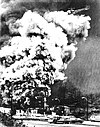Monongah mining disaster

The Monongah Mine disaster of Monongah, West Virginia occurred on December 6, 1907 and has been described as "the worst mining disaster in American History". An explosion thought to have been caused by the ignition of methane (also called "firedamp") ignited the coal dust in mines number 6 and 8, killing hundreds of workers.
Rescue workers could only work in the mines for 15 minutes due to the lack of breathing equipment. Some of those workers also perished due to suffocation caused by methane oxidation.
Officially, the lives of 362 workers including children were lost in the underground explosion, leaving 250 widows and more than 1000 children fatherless. In October 1964 Reverend Everett Francis Briggs stated that "a fairer estimate of the victims of the Monongah Disaster would be upward of 500".[1] This estimate is corroborated by the research of Davitt McAteer, Assistant Secretary for Mine Safety and Health Administration at the United States Department of Labor during the Clinton administration.[2] The exact death toll remains unknown.
Most of those who died were Italian immigrants. On May 1, 2009 the President of the Italian Republic, Giorgio Napolitano, conferred the honour of "Stella al Merito del Lavoro" (Star of Reward of Work) upon the victims of the disaster.
References
- ^ Science, vol. 146, 2 Oct. 1964
- ^ McAteer, Davitt (December 6, 2007). Monongah: The Tragic Story of the 1907 Monongah Mine Disaster, the Worst Industrial Accident in US History. West Virginia University Press. p. 332. ISBN 1-933202-29-7.
External links
- "Italians arrive to honor immigrants killed in 1907 Monongah mine blast:Remembering their countrymen" December 5, 2007 by Marylynne Pitz, Pittsburgh Post-Gazette
- Monongah Remembered--a movie by Argentine Productions (Pittsburgh, PA)
- RAI Radiotelevisione Italiana - Special programme by Gerardo Greco of Italian Television for TG2 Dossier Storie. In Italian.
- "Bell from Italy to toll in Monongah" November 28, 2007 Pittsburgh Post-Gazette
- WVPBS - West Virginia Public Broadcasting
- A document from Boise State University, Idaho.
- U.S. Department of Labor Mine Safety and Health Administration.
- Monongah. La Marcinelle americana - a film on the tragedy by Silvano Console. In Italian.
- Norberto Lombardi, Monongah 1907. Una tragedia dimenticata., a book in Italian from Italian Ministry of Foreign Affairs, 2007.

